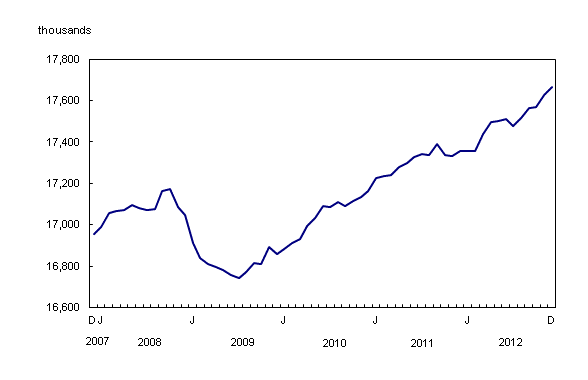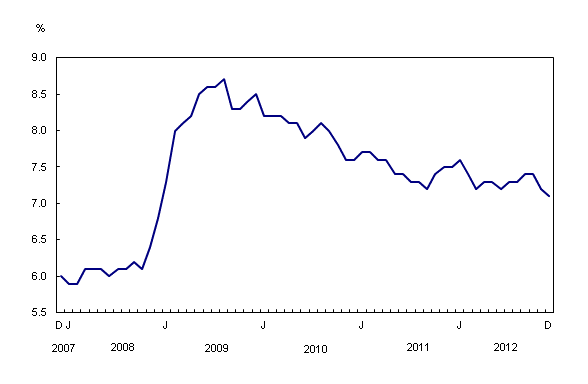Labour Force Survey, December 2012
Archived Content
Information identified as archived is provided for reference, research or recordkeeping purposes. It is not subject to the Government of Canada Web Standards and has not been altered or updated since it was archived. Please "contact us" to request a format other than those available.
Related subjects
-
[an error occurred while processing this directive]
Employment rose by 40,000 in December, the fourth increase in five months. December's increase was all in full-time work. The unemployment rate declined 0.1 percentage points to 7.1%, the lowest in four years.
Employment

Compared with 12 months earlier, employment increased 1.8% or 312,000, all in full-time work. Over the same period, the total number of hours worked rose 1.6%.
Provincially, employment increased in Ontario, Manitoba, Saskatchewan, Newfoundland and Labrador and Prince Edward Island in December. At the same time, there was a decline in Nova Scotia.
Employment rose among private sector employees in December, up 59,000, while there was little change in public sector employment and self-employment.
Year over year, employment gains among private sector employees totaled 242,000 (+2.2%), while public sector employment rose by 92,000 (+2.6%). Over the same period, the number of self-employed was little changed.
Among industries, employment increased in transportation and warehousing as well as construction, while there were fewer workers in professional, scientific and technical services; natural resources; and public administration.
In December, employment increased among core-aged men 25 to 54. Over the year, employment gains were shared among core-aged workers and those 55 and over, while employment among youths was unchanged.
Unemployment rate

Chart description: Unemployment rate
Gains in several provinces
Employment in Ontario rose by 33,000 in December, following an increase of similar magnitude the previous month. The unemployment rate remained at 7.9%, as more people participated in the labour market. Compared with 12 months earlier, employment in the province was up 1.5%, mostly in full time, but below the national growth rate of 1.8%.
In Manitoba, employment was up by 5,200, the fourth increase in five months. The unemployment rate was 5.2% in December, little changed from the previous month, as more people entered the labour force. Compared with 12 months earlier, employment in the province was up 1.9%.
Employment rose by 4,000 in Saskatchewan in December, bringing total growth over the previous 12 months to 3.1%. The unemployment rate was little changed from the previous month at 4.6%, and remained among the lowest of all provinces.
Employment in Newfoundland and Labrador increased by 2,700 and the unemployment rate fell 1.0 percentage point to 11.5% in December. On a year-over-year basis, employment in this province has increased by 3.7%, the highest growth rate of all provinces. The employment rate, although the lowest of all provinces, has been steadily increasing, going from 49.4% in July 2009 to 55.1% in December 2012.
In Prince Edward Island, employment increased by 1,300 and the unemployment rate stood at 11.0% in December. Employment was little changed from 12 months earlier.
Employment in Nova Scotia fell by 5,000 in December, while the unemployment rate increased by 0.5 percentage points to 9.3%. With this employment decline, employment in the province has fallen by 1.9% since December 2011.
In December, employment in New Brunswick was little changed and the unemployment rate was 10.8%. Compared with 12 months earlier, employment was down 1.9%.
In Alberta, employment was little changed for the month, while the unemployment rate increased by 0.3 percentage points as more people searched for work. Despite this increase, Alberta still has the lowest unemployment rate of all provinces at 4.5%. Employment growth over the year was 1.5%, below the national growth rate.
Employment in Quebec was little changed in December and the unemployment rate declined 0.3 percentage points to 7.3% as fewer people searched for work. Employment in this province has grown by 3.5% compared with 12 months earlier.
In British Columbia, employment was little changed in December and the unemployment rate declined 0.3 percentage points to 6.5%. Compared with 12 months earlier, employment was little changed.
Gains in transportation and warehousing as well as construction
In December, there were more people working in transportation and warehousing, up 22,000, bringing employment in this industry to a level similar to that of December 2011.
Employment in construction rose by 18,000 in December. Despite this increase, employment in this industry was little changed from 12 months earlier.
Following an increase the previous month, employment declined by 42,000 in professional, scientific and technical services in December. This decline brought employment down 69,000 (-5.1%) on a year-over-year basis.
Employment in public administration declined by 13,000 in December, and was below its level of 12 months earlier by 23,000 (-2.3%).
Over the year, the highest employment growth rates were in educational services (+8.5%); finance, insurance, real estate and leasing (+6.4%); business, building and other support services (+5.5%); manufacturing (+3.1%); and health care and social assistance (+2.9%).
More men aged 25 to 54 employed in December
Employment in December rose by 41,000 among core-aged men (25 to 54), bringing their gains for the year to 97,000 (+1.6%). The unemployment rate for core-aged men in December was the lowest in four years at 5.9%.
Employment among women aged 25 to 54 was little changed in December and up 60,000 (+1.1%) on a year-over-year basis.
Employment among youths aged 15 to 24 was unchanged in December, and similar to that of 12 months earlier. Their unemployment rate has hovered around 14% for the past two years and was 14.1% in December.
Among persons aged 55 and over, employment was little changed in December, and increased by 164,000 (+5.3%) on a year-over-year basis, driven in part by population aging.
Quarterly update for the territories
The Labour Force Survey also collects labour market information about the territories. This information is produced monthly in the form of three-month moving averages. The following data are not seasonally adjusted; therefore, comparisons should only be made on a year-over-year basis.
In the fourth quarter of 2012, employment levels in all three territories were similar to those in the fourth quarter of 2011. The unemployment rates were 6.1% in Yukon, 7.4% in Northwest Territories and 14.2% in Nunavut in the fourth quarter of 2012, little changed from the fourth quarter of 2011.
Note to readers
Annual average estimates for 2012 are now available on CANSIM (tables 282-0001 to 282-0219).
The Labour Force Survey (LFS) estimates are based on a sample and are therefore subject to sampling variability. As a result, monthly estimates will show more variability than trends observed over longer time periods. Estimates for smaller geographic areas or industries also have more variability. For an explanation of sampling variability of estimates and how to use standard errors to assess this variability, consult the 'Estimates quality' section of the publication Labour Force Information (Catalogue number71-001-X, free).
The employment rate is the number of employed persons as a percentage of the population 15 years of age and over. The rate for a particular group (for example, youth aged 15 to 24) is the number employed in that group as a percentage of the population for that group.
The unemployment rate is the number unemployed as a percentage of the labour force (employed and unemployed).
The participation rate is the number of employed and unemployed as a percentage of the population. For more detailed information, see the Guide to the Labour Force Survey (Catalogue number71-543-G, free).
Unless otherwise stated, this release presents seasonally adjusted estimates, which facilitates comparisons by removing the effects of seasonal variations. For more information on seasonal adjustment, see Seasonal adjustment and identifying economic trends.
Revision
Seasonally adjusted estimates from the LFS will be revised using the latest seasonal factors, going back three years (January 2010 onwards). The revised estimates will be available on CANSIM (tables 282-0087 to 282-0094, 282-0100, 282-0116 and 282-0117) on February 1, 2013.
Available without charge in CANSIM: tables CANSIM table282-0001 to 282-0042, CANSIM table282-0047 to 282-0051, CANSIM table282-0054, CANSIM table282-0055, CANSIM table282-0060 to 282-0063, CANSIM table282-0069 to 282-0089, CANSIM table282-0092 to 282-0095, CANSIM table282-0100 to 282-0121 and CANSIM table282-0200 to 282-0219.
Definitions, data sources and methods: survey number survey number3701.
A more detailed summary, Labour Force Information (Catalogue number71-001-X, free), is now available online for the week ending December 8. From the Key resource module of our website under Publications, choose All subjects, then Labour.
Data tables are also now available online. From the Subject module of our website, choose Labour.
The next release of the Labour Force Survey will be on February 8.
For more information, contact us (toll-free 1-800-263-1136; infostats@statcan.gc.ca).
To enquire about the concepts, methods or data quality of this release, contact Vincent Ferrao (613-951-4750; vincent.ferrao@statcan.gc.ca) or Jeannine Usalcas (613-951-4720; jeannine.usalcas@statcan.gc.ca), Labour Statistics Division.
- Date modified:
